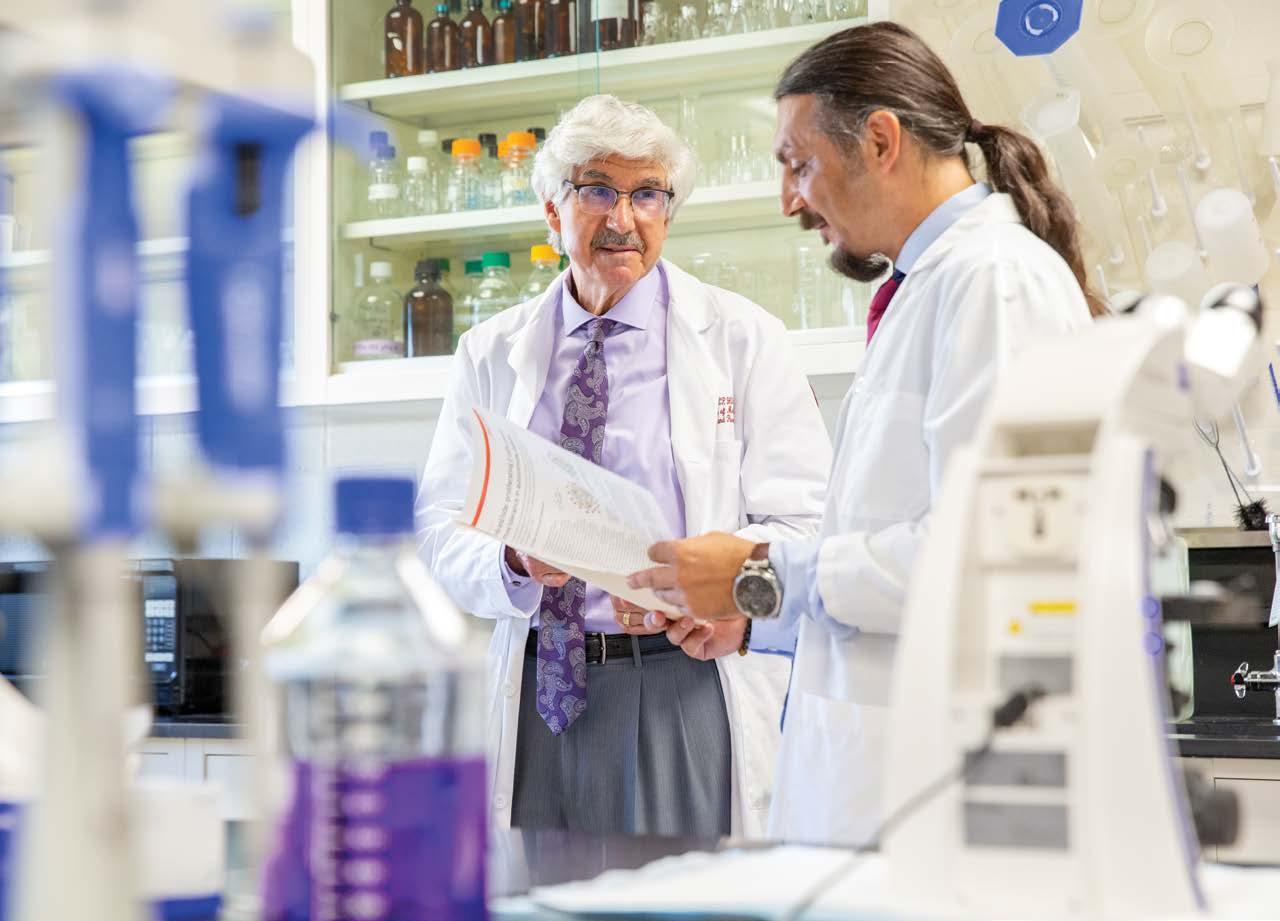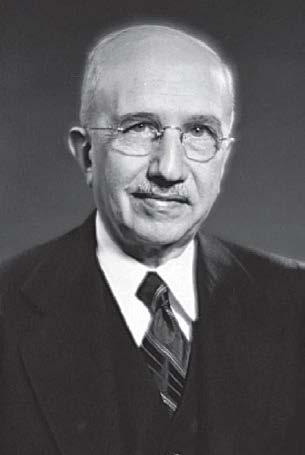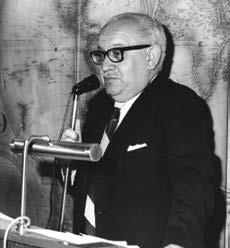
11 minute read
MOUNTING DEFENSES AGAINST DIABETES
How New York Medical College is Committed to Stopping Diabetes in its Tracks
BY MELISSA PHETERSON
After decades of tireless efforts to halt America’s diabetes epidemic, nothing seemed to move the needle — until now. According to a recent study from the Centers for Disease Control, after a 20-year increase, new diabetes cases are in decline. It is the first sign that efforts to stop the nation’s diabetes epidemic are working.
Among those leading the charge is New York Medical College (NYMC) to prevent and treat diabetes on several fronts: from population studies to curriculum enhancements, and from targeted cellular therapies to community nutrition programs. The College’s initiatives have drawn national attention, broke new ground and opened new pathways for patients, physicians and scientists.

PREVENTION AS A CURE
Jerry L. Nadler, M.D., MACP, FAHA, FACE, dean of the School of Medicine and professor of medicine and pharmacology, has treated many diabetes patients as an endocrinologist. As a researcher, he continues NYMC’s work with JDRF’s Network for Pancreatic Organ Donors with Diabetes to identify whether a virus is triggering the immune response involved in causing type 1 diabetes (T1D), also previously known as juvenile diabetes. They are exploring if some form of the Coxsackie virus is a possibility. “We’re part of a worldwide collaboration to identify the virus and possibly develop a vaccine,” Dr. Nadler says. “We’re also pursuing a new treatment that inhibits the enzyme causing inflammation of the pancreas cells. If we can stop the inflammation of the cells that make insulin, we can possibly prevent the damage that leads to diabetes.”
Dr. Nadler recently received a five-year grant from the National Institutes of Health (NIH) to continue this research with investigators at Harvard University and the University of Chicago. He is involved with funded research to study the link between obesity, diabetes and heart disease and identify a new target for treatment to preserve beta cell functions and reduce heart disease. He is also interested in the associations of type 1 and type 2 diabetes (T2D) with COVID-19 related mortality. In his leadership role at NYMC, Dr. Nadler has focused on including guidelines for nutrition and healthy eating into the curriculum for medical students, helping address the T2D that often arises from lifestyle.
“Studies have shown most medical students feel uncomfortable providing information to patients on proper nutrition and healthy eating. Given that nutrition plays a key role in disease prevention, we want our students to understand the science and feel comfortable guiding patients,” Dr. Nadler explains. “Students need to be educated on the science of nutrition, healthy eating opportunities and lifelong wellness through diet.”
With hospital affiliates of NYMC integrating treatment and prevention programs to address diabetes, medical students have the opportunity to partner with nurses, pharmacists and nutritionists in several initiatives throughout the region.
As a physician, Dr. Nadler seeks to eradicate the threat of diabetes—one patient at a time—by citing his own experience. “I have a family history of diabetes. Several years ago, I found that I was gaining weight

Jerry L. Nadler, M.D., MACP, FAHA, FACE, and Ercument Dirice, Ph.D.

and my glycated hemoglobin levels were rising, placing me at risk for diabetes. I made a conscious choice to increase my physical activity and change my diet. I lost more than 40 pounds, I’ve kept it off for two years; and I say to patients: ‘If I can do it, you can do it.’”
OUTREACH REDUCES RISK
Maureen Kennedy, M.S. ’04, Dr.P.H. ’11, assistant professor and director of the Division of Epidemiology in the Department of Public Health, School of Health Sciences and Practice, focuses on the causes and conditions driving diabetes with a broad, population-based view. “While epidemiology often focuses on infectious disease, it’s just a small piece of public health,” she explains. “The picture isn’t complete without thinking about chronic disease, too, especially given the crossover between infectious disease and chronic disease.” The challenge with chronic diseases, she adds, is the difficulty of curing them. “Chronic diseases are not going away quickly,” she says. “It’s not as easy as taking antibiotics or a few pills. It’s behavioral changes – not a quick fix.” Like Dr. Nadler, Dr. Kennedy’s efforts have personal meaning. “My mother is diabetic and manages her condition well, but my grandmother lost a leg from the disease,” she says. “So, my public health studies have a powerful connection to my life and family history.”
Dr. Kennedy has directed analytical research studies regarding childhood obesity, hypertension and cardiovascular disease, in addition to diabetes and prediabetes. But these conditions often occur together, so that studying one can shed light on others. “Chronic diseases are so intertwined,” she explains.
In 2018, Dr. Kennedy and her epidemiology capstone class performed an extensive population study regarding diabetes using National Health and Nutrition Examination Survey (NHANES) data. With cross-sectional survey analyses, the data captures trends over 12 years to shed light on potential risk factors for disease. The results surprised Dr. Kennedy and her students.

“We’ve always known that poorer populations, obese populations and elderly populations, age 60 and over, have the highest risk of [type 2] diabetes,” she says. “But the NHANES data showed an increased prevalence of diabetes in middle-class populations, people who were overweight—not obese—and 40-to59-year-olds. That is telling and important, because it tells us we need to broaden our target audience for intervention and initiatives for prevention.”
Dr. Kennedy plans to monitor the prevalence of diabetes in overweight populations, especially as weight issues can begin in childhood and busy families rely on fast food or impulsive choices.
“We might not associate being overweight as being unhealthy but if it will make someone more susceptible to diabetes, we should,” she says. “And to a large extent, weight is driven by eating habits.”
Dr. Kennedy wants to hone in on the condition of prediabetes as another prevention strategy, drawing on her background in clinical laboratory sciences to analyze clinical data to support those newly at risk. “We have a wealth of opportunity here for collaboration,” she says.
— Dr. Nadler

Dr. Nadler emphasizes the connection between public health and patient care is an important piece to the puzzle. “The technology that distracts us, the temptation to grab fast food, the lack of access to nutritious options – all these are working against our health,” he says. “The idea that you can get diabetes without obesity might be surprising; but the fact is that certain types of fat, called central fat or visceral fat, are not always visible on the outside. That central fat leads to inflammation, which leads to diabetes.” Many fad diets do not work because they are not sustainable and exercise alone is not enough to address the problem. “Reducing our portion sizes, making better choices and eating more slowly are critical,” he says. “Our community programs hope to promote that lifestyle change.”
BETA TESTING
Other basic science researchers at NYMC are peering not through broad lenses, but through microscopes. One is Ercument Dirice, Ph.D., assistant professor of pharmacology, who recently joined NYMC from the Joslin Diabetes Center at Harvard Medical School.
Dr. Dirice’s interest in diabetes began when he saw friends with type 1 diabetes halting activities for insulin injections. “I was curious why they had to inject insulin every day.” Knowing that insulin regulates blood glucose levels, Dr. Dirice began to research methods to prolong the survival of the insulin-producing beta cells in the pancreas, known as pancreatic islets, that are destroyed as diabetes progresses.
One lab study used gene therapy to isolate a molecule called TRAIL, introduce it to islets in rats and transplant the islets into diabetic mice to study how resistant they were to cell destruction. “We found that islet cell survival was two to three times better in animals treated with TRAIL,” says Dr. Dirice. The same year, he began looking for molecules that would stimulate regrowth of these cells. Because diabetes is an attack the body wages against its own tissue, he focused on the T-cells that regulate the body’s immune response. He found that at the onset of diabetes, the T-cells secrete certain proteins, called cytokines and chemokines, that can promote regeneration of beta cells, in mice. “We wondered: What if we increased the beta cells before the T-cells begin to attack the islets?” he says.
Over six years, stimulating beta cell growth in mice managed to keep diabetes at bay, and immune cells tamed, for two years in mice. He is now pursuing a followup study to increase the beneficial types of T-cells, which suppress the spread of toxic T-cells. “We found that when we increased the proliferation of beta cells, we found islets were protecting themselves from destruction and suppressing the immune system’s attack,” he says. “That combination is exactly what we seek in fighting T1D.” Looking more closely into the mechanism, Dr. Dirice wondered whether certain beta cell peptides were able to hide from or dodge the immune system’s attack. He is now working on isolating beta cells to evaluate their traits. “If we have a subgroup of beta cells that is completely protected from any immune attack, toxic agent or environmental stress, we can create beta cell replacement therapies to extend that population of cells resistant to destruction. If we can bolster the absolute number of beta cells, it would be a promising approach for T1D patients.”
Dr. Dirice is also working with the Department of Surgery to develop a library of pancreatic tissue samples, which will help with “bench-to-bedside” translational research.
“Dr. Nadler is supportive and providing everything possible for my diabetes research; and his expertise and background in islet cell and beta cell biology is a complement to my approach,” he explains. “We are now poised to research unidentified molecules, testing on mouse and human beta cells, signaling pathways and islet biology.”

START-UPS AND SOIL
Dr. Nadler highlights BioInc@NYMC, the biotechnology incubator on campus, as a source for cutting-edge research and a key partner for fighting diabetes. Among the biomedical start-ups within BioInc@ NYMC is a company researching a method for reducing cravings for sugar, which can contribute to T2D.
Furthermore, he says, Westchester County and the Hudson Valley are rich in resources to support healthy lifestyles: organic farms, culinary centers and acclaimed chefs committed to sustainable eating.
“With our affiliate hospitals, research labs, bio-incubator and regional landscape, we are uniquely positioned to have a major impact on diabetes,” Dr. Nadler says. It’s an environment ripe for synergistic research, including Dr. Nadler’s most recent collaboration—a $804,755 NIH-grant for research to be conducted in collaboration with Dr. Dirice and Raghu Mirmira, M.D., Ph.D., professor of medicine at the University of Chicago, aimed at developing new antiinflammatory treatments for T1D and T2D. “In my view, the future is bright.” ■ New York Medical College’s fight against diabetes stretches back nearly a century, as professors and deans made discoveries that shaped understanding and treatment of the disease. “We are proud to have a tradition of groundbreaking diabetes research,” Dr. Nadler says. “I look forward to carrying on the legacy by rebuilding our efforts.”

ISRAEL KLEINER, PH.D.,
was a biochemist who first identified the effects of an extract on the pancreas, observing that it lowered blood sugar in animals. It would later be known as insulin. After working at the Rockefeller Institute and Tulane University, he joined NYMC in 1919 as a professor of physiological chemistry, serving as dean from 1921 until 1925. In 1948, he became the director of the Department of Physiological Chemistry. Dr. Kleiner co-authored highly regarded textbooks such as Human Biochemistry (with James M. Orten) and Laboratory Instructions in Biochemistry (with Louis B. Dotti). He was the 1959 recipient of the Van Skye Award in Clinical Chemistry from the New York Academy of Sciences.
RACHMIEL LEVINE, M.D.,
former professor and chair of the Department of Medicine at NYMC, was a pioneering physician and leading diabetes researcher who broke new ground by discovering the role and function of insulin in glucose metabolism in 1946. His findings were controversial, as they defied the belief that glucose molecules could travel freely across cell membranes, without dependence on insulin. In 1960, Dr. Levine joined NYMC and the following year, he received the highest honor from the American Diabetes Association. Building on his findings, Dr. Levine supported scientists in developing the first genetically engineered insulin for humans, called Humulin. In the 1980s, Dr. Levine worked with Dr. Nadler at City of Hope, a major cancer research center in California.












